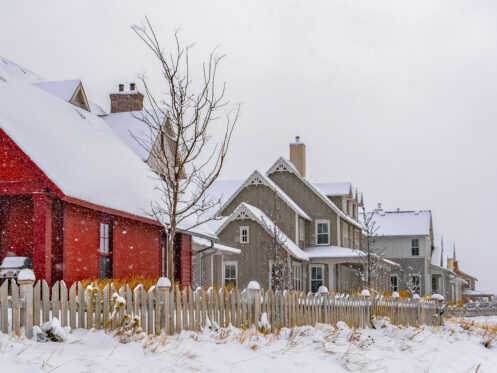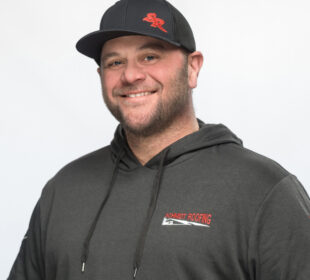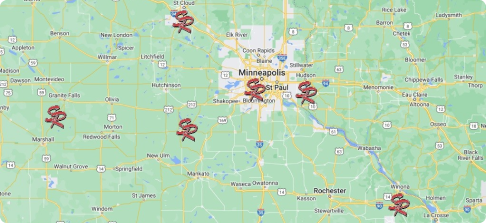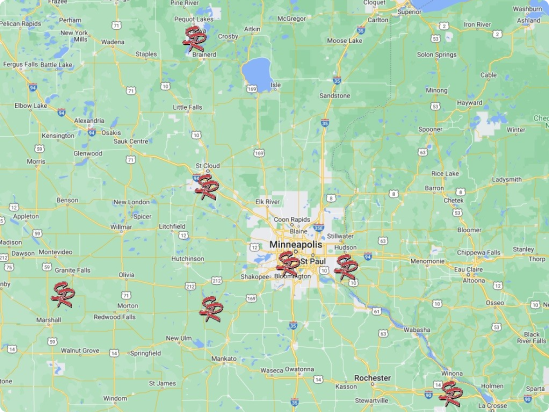Cold winds and heavy snowfall can turn minor roof issues into leaks or ice dams once Minnesota’s winter arrives. A thorough inspection now helps you spot problems that could otherwise lead to water damage, mold, or — in severe cases — structural concerns when temperatures drop.
At Schmidt Roofing, in Burnsville, MN, we assist homeowners with each inspection step so you face winter with confidence rather than emergency repairs.
Examine Shingles and Roofing Material
An inspection begins by scanning your roof surface to look for missing, cracked, or curling shingles. Curling or cracked shingles often signal age and weather wear, leaving those areas vulnerable to melting snow seeping underneath. If you see patches where shingles have lost their granules, the asphalt beneath is exposed and may not shed water effectively.
Damage also makes it more likely for shingles to blow off during a winter storm. You may not notice missing shingles until spring, by which time leaks and hidden damage may have occurred.
Instead of “pooling water,” the real risk on pitched shingle roofs is reduced water-shedding ability and ice forming at weak points. Prolonged moisture can lead to soft or rotting decking beneath. If your roof features metal panels, we will check for rust or loose fasteners that leave gaps at seams. Taking note of soft or sagging spots may uncover underlying wood rot. We will assess whether spot repairs or a full roof replacement makes sense before winter sets in.
Inspect Flashing and Roof Penetrations
Flashing around chimneys, vents, and skylights guards against leaks. We will inspect flashing and look for cracked sealant, rust, or missing fasteners. Rusted flashing can develop pinholes that allow water to enter. Loose flashing is usually caused by weather or nail failure—not structural settling.
If flashing at a plumbing vent shows gaps, wind-driven snow can enter the attic. Rubber boots around vent pipes can degrade over time from UV exposure, typically over a decade or more. A torn or brittle collar can let moisture trickle into insulation, reducing its effectiveness. Ensuring flashing sits flat and sealed prevents leaks that may otherwise go unnoticed until spring, when mold or water stains appear.
Clear and Evaluate Gutters and Downspouts
Clogged gutters and misaligned downspouts lead to water backing up under roof edges, forming ice dams that lift shingles. We will walk your property’s perimeter and look for overflow stains or icicle formations along the eaves, which signal poor drainage.
We check that each gutter slopes slightly toward the downspout and remains securely attached. Sagging sections collect debris and trap melting snow. Downspouts that discharge too close to the foundation can saturate soil and allow water to seep into basements during freeze-thaw cycles. While it’s unlikely to crack the foundation directly, it does increase the risk of seepage or leaks.
Be sure to periodically clean each gutter and flush it with water to confirm there are no obstructions. Install gutter guards to reduce debris buildup, and schedule a professional roof-to-ground system check to confirm proper pitch and fastening.
Evaluate Attic Ventilation and Insulation
From inside your attic, check the eaves and underlayment for daylight shining through seams or gaps. Tiny pinpoints at nail holes aren’t always a problem, but visible lines of light can indicate leak paths. Soffit vents should remain clear, allowing fresh air to enter, while ridge vents must be unobstructed so warm, moist air can escape.
Good airflow prevents hot spots that melt snow in patches and refreeze at the colder roof edges, causing ice dams. An insulation check is also important. Gaps or underinsulated areas allow heat from your living space to rise into the attic, melting snow on the roof above and fueling ice buildup at the eaves.
Inspect Chimneys and Skylights
Chimneys and skylights often escape routine checks yet represent critical leak points. Examination of chimney masonry for cracked mortar joints or missing capstones should occur annually. A loose chimney crown can let water infiltrate masonry or the chimney chase, eventually causing interior wall damage.
A failing skylight gasket may allow snowmelt to seep under flashing and into the attic. Ice buildup can stress seals, making leaks more likely. Documenting every defect lets a professional reseal or replace flashing and repair masonry before winter weather arrives.
Install Snow Guards and Safety Features
After clearing debris and sealing vulnerabilities, consider adding snow guards to protect your home come winter. These brackets or rails attach just above the eaves to hold accumulated snow in place, preventing sudden slides that could damage gutter systems or injure people nearby. Snow guards are excellent for controlling snow movement, though they don’t prevent ice dams, which are best addressed through insulation and ventilation improvements.
Assess Nearby Trees and Overhanging Branches
Trees add beauty but pose risks when limbs overhang your roof. Wind and heavy snow can bend branches until they scrape shingles or snap off entirely, causing damage. From your lawn, look for branches close enough to touch or fall on your roof. Any contact during storms can lead to leaks or surface wear.
Hire a professional arborist each year to trim or remove problem limbs. Clearing overhead foliage also reduces shade, letting roof surfaces dry more quickly after precipitation. Less shade means less moss or mold growth on shingles.
Schedule a Professional Roof Inspection and Tune-Up
A hands-on inspection by a certified roofer with the right tools — like moisture meters or thermal cameras — can detect hidden damage beneath shingles or flashing. We can confirm proper nail placement, reseal exposed fasteners, and replace worn flashing. For flat or metal roofs, protective coatings may be applied, though coatings are not standard for asphalt shingles and may void warranties.
For homes prone to ice dams, heated cables can be installed in targeted areas as a supplemental solution. They help melt ice where needed, but they should be paired with attic insulation and ventilation improvements for long-term prevention.
Get Your Roof Inspected to Protect It for Winter
A pre-winter professional tune-up completes your DIY efforts and sets your roof up to withstand Minnesota’s toughest weather. A thorough inspection now helps you avoid surprise leaks, ice dams, or water damage when snow piles up.
We also provide gutter cleaning, attic insulation upgrades, and heated cable installation to protect your home through the winter season.
Call Schmidt Roofing today to schedule your roof inspection or roof repair in Burnsville.



